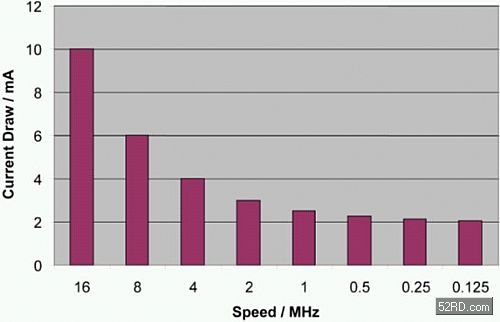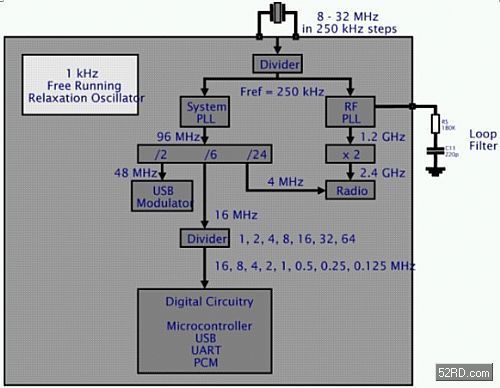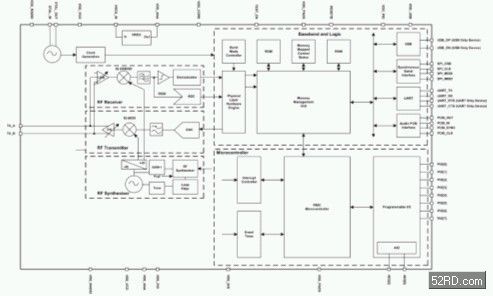Power consumption is a key factor in determining the success or failure of a portable device. As the trend of such devices evolves toward functional convergence, the most obvious sign is that megapixel digital cameras are integrated into camera phones, and new multi-function devices must continue to cater to consumer demand, especially in terms of power consumption.
This article refers to the address: http://
Although Bluetooth itself is already a low-power technology, in order to further extend battery life, the Bluetooth SIG continues to integrate many new methods to reduce the power consumption of the new Bluetooth specification. In November 2004, the Bluetooth SIG revised the 2.0+ Enhanced Data Rate (EDR) specification, combining a revolutionary technology to create a more efficient wireless link and data packet delivery mechanism.
The most important way for the Bluetooth SIG to reduce the power consumption of Bluetooth devices is to develop EDR Bluetooth. The power consumed by a Bluetooth radio depends on how long it takes to operate. The v2.0+EDR Bluetooth specification allows data transfer speeds up to three times that of traditional Bluetooth (3 Mbps vs. 1 Mbps), which means that the radio wave operation time is reduced by a third, so the power consumption is reduced to one-third.
The increased data transfer rate is attributed to a radical change in the way data packets are transmitted.
The standard transmission rate (1Mbps – for example, the Bluetooth version like v1.2) has four parts:
1. Access Code – The receiving device uses this access code to identify the transmission at the input.
2. Header – describes the type and length of the packet
3. The contents of the package (Payload) – the actual content of the data transmitted
4. Cross-packet Guard Band (Inter-packet Guard Band) – Transfer radio waves to the next band
All three transmission parts use Gaussian Frequency Shift Keying (GFSK) to process RF signals: The carrier frequency offset ranges from plus or minus 160 kHz to represent zero or one, each symbol ( Symbol) encodes a bit. The symbol transmission rate is 1 Msps (Mega Symbol Per Second). The resources required for the access code, header, and guard band are three parts, allowing the highest load data rate to reach 723 kbps.
The Bluetooth EDR packet still uses the GFSK modulation mechanism for the access code and the header, but the Payload data uses one of the following two different modulation mechanisms: One is mandatory, providing twice the data transmission rate, Allows for higher noise; the other is a selective modulation mechanism that provides 3 times the data transfer rate.
The 2x data transfer rate is π/4 Differential Quadrature Phase Shift key shift or π/4-DQPSK technology. This modulation mechanism changes the phase of the carrier rather than the frequency. "Quadrature" means that each symbol has four possible phases, so that two data bits in each symbol can be encoded. The symbol rate remains the same; therefore, the data transfer rate is doubled.
The 3x data transfer rate is 8-DPK (8-Phase Differential Phase Shift Keying). This mechanism is similar to π/4-DQPSK, but can be moved to any of the 8 possible phases. The reduced phase difference between adjacent positions, plus the use of ±π phase hopping, means that 8-DPSK is more susceptible to interference, but each symbol can encode 3 bits of data.
After the success of the EDR specification entered the actual product phase, the products that passed the inspection were asked in 2005, and the SIG continued to study various new methods to reduce power consumption. CSR BlueCore further reduces the power consumption of CSR's BlueCore chip's built-in hardware clock with low-power mode and internal clock, which separates digital components from the radio; turns off the radio; and switches the wafer to shallow or deep sleep mode. This provides low power consumption that even exceeds the official Bluetooth SIG standard.
Low power mode and internal clock
The hardware clock within the BlueCore chip separates the digital component from the radio; turns off the radio; and switches the wafer to a shallow or deep sleep mode.

Figure 1 Power consumption in shallow sleep mode
In the shallow sleep mode, the clock speed is reduced from 16MHz to 0.125MHz, and the current is reduced from 10mA to 2mA (as shown in Figure 1).

Figure 2 Clock structure of deep sleep mode
In deep sleep mode, the main crystal plus all other clock components are turned off, leaving only 1 kHz for the Oscillator (as shown in Figure 2).
BlueCore requires 20milliseconds (ms) of no job idle time when switching to deep sleep mode. In terms of wake-up, the crystal takes 5ms to restart, and the component requires about 20ms of no-time (predict). BlueCore can wake up the component before the next scheduled job through the scheduling alarm, or the PIO, UART, or USB link to the transmitter interrupt, to leave the deep sleep mode.
Wafer architecture

Figure 3 BlueCore3-ROM CSP chip package
The BlueCore chip architecture itself plays an important role in ensuring power efficiency and reducing power consumption. Figure 3 shows a BlueCore3-ROM CSP wafer-level package design showing the typical configuration of a BlueCore chip.
The CSR was transferred from 0.18 micron to 0.13 micron process, and the fifth generation of BlueCore5 components of CSR was developed, which had a significant impact on power consumption. As silicon components become smaller and smaller, communication between different components in the wafer becomes more efficient, and the same functionality can now be done with only a small amount of power.
DSP: Reduce power consumption and improve performance
CSR chose to use a DSP architecture in a single-chip specification, bringing a breakthrough solution in the stereo and mono headset market. In terms of stereo headphones, consumers hope that their headphone battery life can match the battery life of the music player. Today's iPods offer a very long battery life (10 to 15 hours), far better than a typical mobile phone. Stereo headphones must achieve similar battery life without excessively consuming the battery power of the music player or mobile phone.
The BlueCore multimedia products use DSPs to help CSRs enable wireless headsets to achieve 10 to 16 hours of endurance (BlueCore3-MM and BlueCore5-MM, respectively), far surpassing the best products from other manufacturers. These non-DSP solutions have the highest endurance. Only 5 hours.
Why is the integration of the DSP architecture to greatly improve the battery life? The power consumption of the DSP architecture is far lower than that of other manufacturers using ARM processors, and the DSP supports various music formats in the native mode, such as MP3. , WMA, and AAC. Native support capabilities eliminate the need for inefficient and energy-intensive codecs, such as the use of SBC wireless technology to deliver music files.
To ensure interoperability, all products that use the Bluetooth AV profile must be able to interoperate with the Bluetooth SIG mandatory compression encoding/decoding mechanism: Subband Coding (SBC) technology. Although this standard is quite practical, it is inconsistent with the music storage formats that are currently popular among consumers. Therefore, if the headset only supports SBC, the music player or mobile phone must perform the transcoding operation, decompress it before transmission, and then compress it again. Performing this function not only affects the quality of the music, but the transcoding operation itself consumes a lot of processor resources. In some typical processor cores used in today's mobile phones, 80% of the processor bandwidth is used. This kind of operation that consumes a lot of processor resources requires a lot of power, which puts more pressure on battery life.
In addition, in terms of reducing the file size, the SBC is not as efficient as the MP3 format, so it requires higher periodic resources for streaming. This will affect the reliability of the connection and will also consume more battery power.
In order to solve the problem of low efficiency and power consumption derived from transcoding, CSR developed a proprietary Bluetooth stereo headphone reference design using DSP-based BlueCore multimedia components, combined with SBC and MP3 format encoding software. By supporting the MP3 encoding function, there is no need to transcode, and the power consumed to transmit MP3 files is lower than in the past. In a typical headphone reference design - BlueTunes 1 uses Bluecore3-MM – consumes less than 95mW (25mA and 3.7V – equivalent to top-of-the-line monophony in 2004 when receiving streaming SBC music over standard non-EDR channels The power consumption of the headphones). This design greatly reduces the power consumption of transmitting MP3 files and still supports EDR.
Casual scans from time to time
When not connected to other devices, the Bluetooth radio will operate in "call scan" or standby mode, allowing radio waves to search the RF range of other connectable devices every 1.28 seconds, and send a radio wave after scanning to other devices. The recognizer goes to the local device to establish a connection when needed. CSR has been using new technologies to reduce the amount of activity required in call scan mode, thus further reducing power consumption. One of the methods is to use a frequency that is synchronized with the GSM signal (beacon), scan the range of the RF wave, use the available power to scan the RF range, and the handheld device establishes a recognition mechanism in the GSM network. . This approach further develops a "conditional scanning" mechanism that allows the device to scan the RF range. If there is no RF wave activity, there is no need to perform a full call scan, and the device can wait until the next scan cycle to see if there are other devices nearby.
in conclusion
For handheld device manufacturers, power consumption is always one of the main considerations. In the face of the problem of power consumption, the industry must also respond to consumer demand for product performance, functionality, interoperability, and connectivity. Bluetooth is the most suitable wireless transmission technology for battery-powered devices and should provide powerful features at the lowest power requirements. As a result, the Bluetooth SIG and various industry players are working to improve the performance of new or new Bluetooth devices. The use of DSP architecture to enhance multimedia performance not only further reduces power consumption, but also provides support and performance for different applications. It can be used as a reference for the development of Bluetooth product manufacturers.
Bird Repeller System, Insect Killer,Shears,Garden Sprayer
Electronic Fence System,Bird Repeller System Co., Ltd. , http://www.nbelectronicfence.com